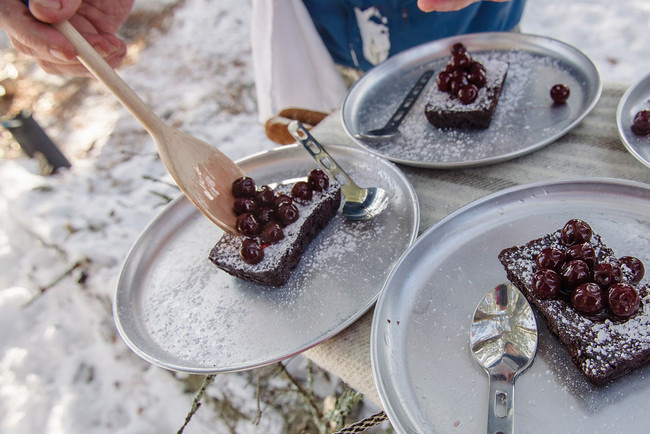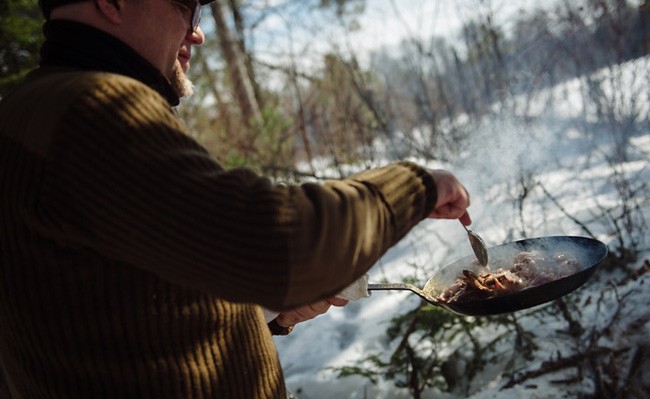
This story was sponsored by the Campaign to Save the Boundary Waters. It’s the third of a five-part series that will run on Heavy Table. Chef J.D. Fratzke of the Strip Club Meat and Fish cooked a wilderness feast in the Boundary Waters Canoe Area for a group of six travelers — you can read all about it here. These are his notes — about his relationship with the Boundary Waters, about finding food in the wild, and about how he cooked that meal.
The last time I came up to the Boundary Waters on a solo trip was in September of 2014. I set up my camp on an island in Newfound Lake about two miles from Prairie Portage, an old voyageur route that serves as the gateway to Quetico on the border with Canada. The sun set while I made myself a humble supper of noodles in broth with chunks of kielbasa sausage. I snuggled up to a log bench and ate straight from the pan by the light of my headlamp. Gorged and exhausted, I stoked up my campfire, pulled Jim Harrison’s The Road Home from my dry bag, and settled into the old wolf’s storytelling.
When I started to nod off, I looked up from the pages and out over the lake. An odd, pale smoke seemed to be coating everything. My fire wasn’t the source; it had burned down to coals. The air was dry, so I knew it wasn’t fog. I turned off my lamp and stood up and realized I was casting a shadow. Turning around, I was lit up by the brightest full moon I’d ever seen. Stumbling dumbfounded to the rocky point of the island, I felt like I had stepped into the spotlight of some ancient stage. I was struck, in that light, with the notion of the tens of thousands of moons these waters had absorbed, the storms, the snowfalls, the people like me and so unlike me who had slept where I was sleeping.

The wonder of the Boundary Waters is its ability to place us in vastness. In a sense, like all true wilderness, it is a time machine. It is one of the few places where we can walk through pure prehistory — and it is every Minnesotan’s birthright. We should all be proud of that. We should all make an effort to protect that.
When James and Becca invited me to make a winter trip up to Ely and cook outdoors for Dave and Amy, I leapt at the chance. I’m a true believer when it comes to Save the Boundary Waters, and I had followed the Freemans’ trip on Twitter. I considered it a tremendous honor to cook for them. James and I discussed logistics, I squared the day away with my family and my staff, and I set to work on a menu.
Time would be tight, leaving after a busy Saturday dinner service. I thought about the hike in, what we could carry, what kind of calories we would need, what we could do over open fire and a wood stove, and how I could best bring all of the heart of the Boundary Waters into the meal. My mind went to work: Sunday morning? We’ll need a bloody mary. Grab the house mix and a bottle of Prairie Vodka.
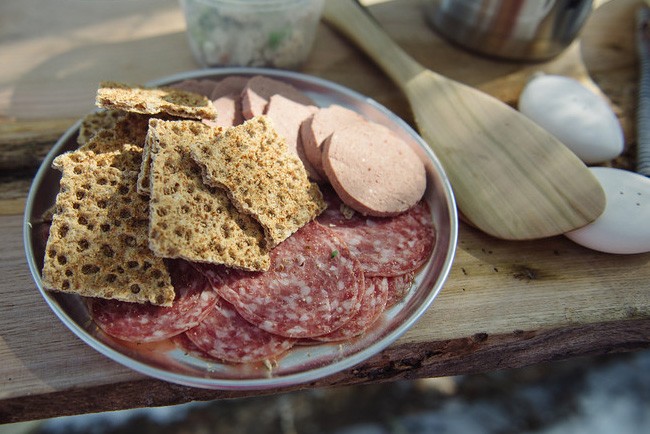
While I prep, they’ll need nibbles with the drinks. Braunschweiger and salami on crackers. Can’t do the BWCA without walleye; smoke some fillets and make a mousse to go along with the cold cuts. Buffalo quail over the campfire will warm everyone from the inside out. Venison for sure … as ancient as MN itself.
Ducks too? Their eggs with the venison like a steak and eggs. Their legs confit-ed and simmered with beans — for loads of carbs to fuel the hike out. Wild rice polenta like grits. Add pemmican to tell the story of voyageurs and their rubaboo. Sweets to finish. Chocolate for energy. Chris’s brownies and the griottes cherries. Dust them with powdered sugar to look like the snow surrounding us. Spruce tea for warmth, digestion, vitamin C, and a taste of the Ojibwe traditions we’ll need to honor …
Knives, pans, eats, and towels got boxed up, the preplist was ticked off, snowshoes and thermals stowed in the back seat. My mom’s knit hats as gifts for all my new friends. I kissed my girls goodbye as they slept, fired up the Subaru, cranked up The Tragically Hip, and rocketed north in darkness to the Boundary Waters Canoe Area Wilderness, that grand cathedral of ice and pines.

We had a glorious day in great part to Steve and Steve having set up camp with a couple of roaring fires. The warm tent made for a fine refuge and good company. The day flew by, the food was easy to cook and gratefully had by all. While the venison was being devoured, I took a deep pull of 18 year old scotch from James’ flask, excused myself from the tent for a minute and walked about fifty yards out into Fall Lake. I breathed deeply in the brightness of the afternoon and felt myself swell with a familiar rush of emotion — one I’ve felt in every trip I’ve ever taken to the Boundary Waters – that of gratitude and true happiness. I’d offer that the greatest gift of wilderness is how it allows us to be our truest selves in a place of purity. While that can be had in solitude, it is even better savored with friends who delight in sharing the experience. I’m blessed to say on this day, for me, it certainly was.
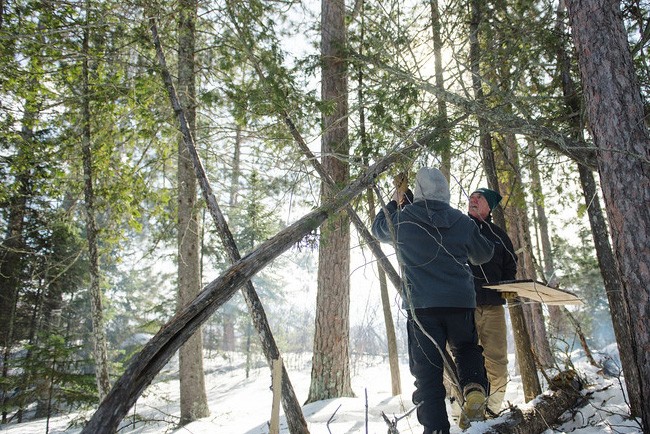
NOTES FROM A FEAST: MARCH 1, 2015, FALL LAKE
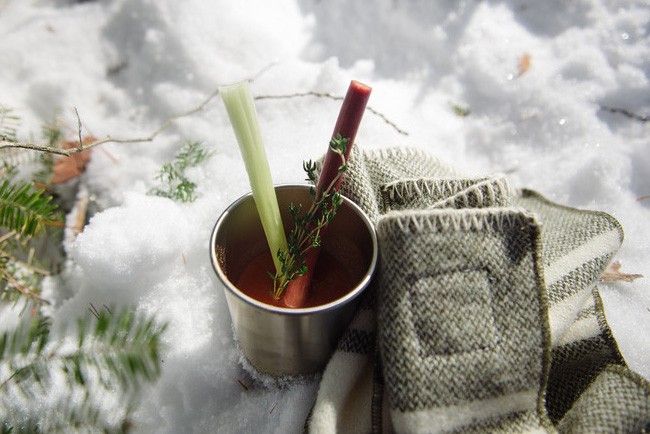
First Taste: Bloody Mary
I knew that despite the cold and the early hour, after the trek in, a Sunday morning Bloody Mary would be a quick, restorative, liquid breakfast. I wanted to introduce the meal to everyone by giving them The Strip Club Meat and Fish in a cup; a generous portion of MN’s own Prairie Vodka, Grass Run Farms grass-fed beef stick, celery that got frosty on the trek in, and to give everyone an aroma of the warmer season to come, a sprig of fresh thyme.
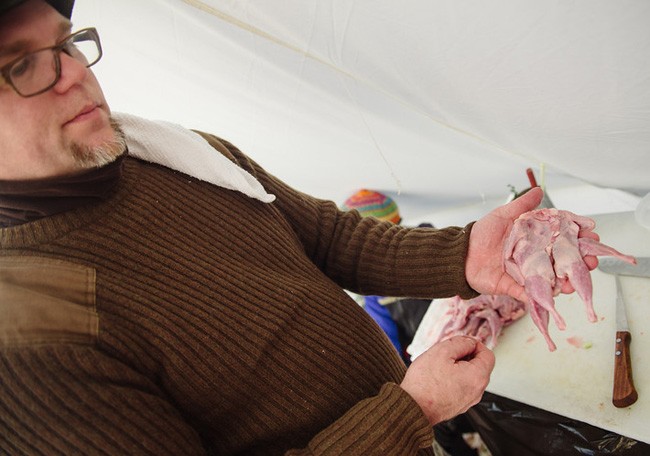
Appetizer: Buffalo-style Quail
I’ve always felt like most chefs treat wild game with too much reverence and as a result, those who didn’t grow up with it aren’t drawn to it. The sweet, tender dark meat of quail is the perfect ‘gateway drug’ to introduce someone to wild game, especially with a preparation as familiar and addictive as drowning them in Buffalo sauce.
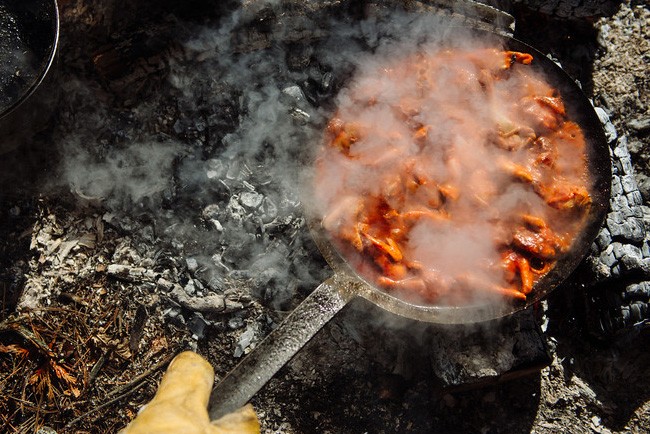
Compound the fact that the degree of heat from the chilies warms you from the inside out and you have a perfect dish for deep winter campfire cooking in MN. We ran this dish on the menu at TSC for over a year.
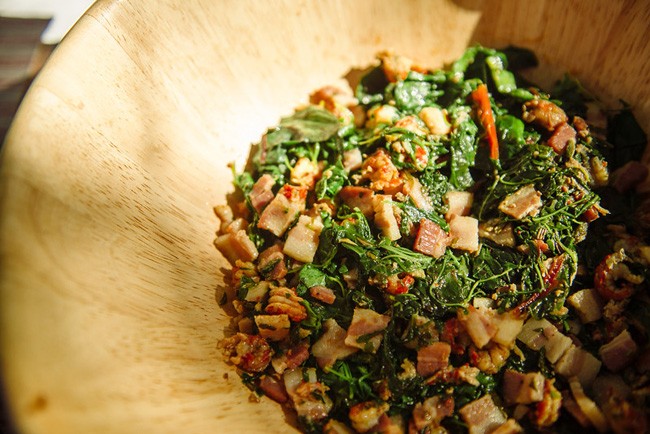
Salad: Bitter Greens braised in Crayfish tails and Bacon
Vegetables are often missing from the hearty meals we tend to celebrate in the wilderness. A pity, really, because in addition to being delicious, they aid digestion and augment the carbohydrates and massive proteins that usually encompass most trail meals.
Pack in a small amount of fresh greens for the first night of your trip as the delicate refrigeration they require is usually not available. Depending on the time of year and your level of knowledge, some leafy vegetables like watercress or dandelion greens can be foraged.
Place a half cup of chopped bacon in a saucepan over the coals of your campfire. When the bacon has rendered out enough fat to coat the bottom of the pan, add a small yellow onion, diced, and a minced clove of garlic. When the onions are translucent, add a half cup of crayfish tails (easily scored from a local fishmonger like Coastal Seafood or at an Asian grocery) and two cups of water. At this point you can also add a splash of white wine or beer if you brought some along. Shift the pan to hotter coals, bring to a boil and reduce liquid to about half. Season with salt and pepper and any dry herbs you may have brought. Add fresh leafy greens like watercress, dandelion greens, arugula, chard, kale, or a mixture of any and all to the pot. Cover for about three minutes; the greens will have wilted considerably.
Stir well to evenly distribute the ingredients. Taste, season accordingly, and have at it.

Main: Wine-Glazed Venison Tenderloins with a Rubaboo Polenta “Trencher”
When the first Voyageurs made their way to the western Great Lakes, most had begun to exhaust the supplies of salt pork and flour that had made the journey with them from Montreal. As they traded with native tribes along the way, they were introduced to ancient staples of the region like mahnomin (wild rice) and pemmican (pulverized bison or venison mixed into a paste with fruit and dried into jerky).
Because the Voyageurs were French, when it came to food they would not leave well enough alone — thus the birth of rubaboo. What eventually became a deep country tradition, rubaboo was a roux-based stew loaded with salt pork, pemmican and when available– wild rice. It was something the voyageurs looked forward to as a hearty meal at the end of a full day of paddling and portaging.
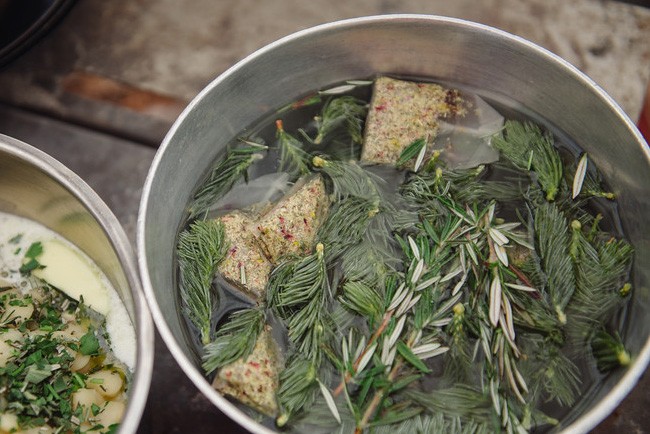
Beverage: Spruce-Tip Tea
Spruce-tip tea has been a healing and restorative brew for native peoples for thousands of years. It contains a wealth of vitamin C, helps improve eyesight, fights fatigue, and improves cardiovascular functions – all integral elements of a lifestyle that relies on the pursuit of wild game. It also, of course, tastes delicious. I added Tazo “Calm” tea for its hibiscus and chamomile to bring out the sweetness of the brew a bit more and bring the feeling of warm sunshine – something we can’t get enough of during February in Minnesota.
Sipping spruce tea, a traditional Ojibwe restorative, is a way to taste that history and make yourself a part of it. You will need about one heaping cup of rinsed, new growth spruce tips. They can be sourced online or at a homebrewing supply outfit. You can, of course, forage them yourself, but stick to the bright, lime-green new growth available in spring. Older spruce is strong and acrid. Also, be sure to thoroughly wash and rinse any foraged spruce tips to avoid giardia from the bird droppings — that will not improve your experience.
Place the heaping cup of spruce tips in a saucepan or teapot with about three cups of water. I add two packages of Tazo “Calm” tea because I like the sweet, floral flavors of the chamomile and lemongrass with the tartness and mint of the spruce. You could also stir in a little Minnesotan honey, if you prefer.
Place saucepan on embers of campfire and bring to a boil for about three minutes. Remove from heat and let steep for at least ten minutes. Strain into cup. Sip and heal thyself.
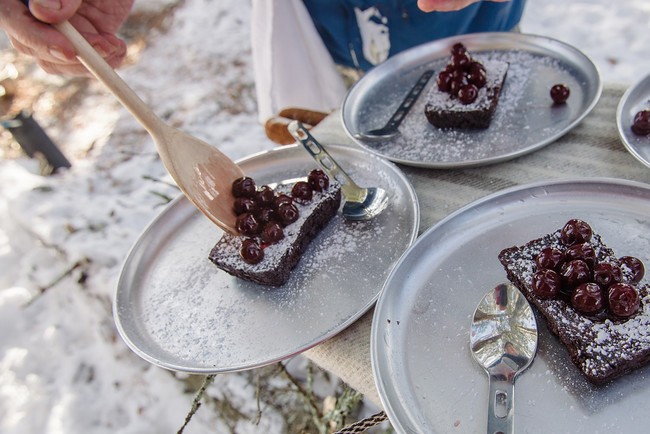
Dessert: Backpack Brownies
4 oz butter
⅔ c cocoa powder
¼ c all-purpose flour
½ tsp salt
2 eggs
½ c white sugar
½ c brown sugar
½ c bittersweet chocolate chips
Cognac-marinated cherries
Powdered sugar (to dust)
After a hard day’s haul, few things are more rewarding than a few bites of something sweet after a good meal in front of the warmth of flames and embers. The brownies I brought up to the Fall Lake were baked at the restaurant, wrapped in foil and reheated over the coals of the campfire, though they just as easily could have been eaten cold like the world’s greatest energy bar. We have my sous chef, Chris Uhrich, to thank for these chocolate monoliths. Chris is a mad genius when it comes to doughs, batters, and sweet things. He’s owned our pastry program at The Strip Club Meat and Fish for the past eighteen months and has brought our desserts to a grand level of deliciousness and creativity. The following is his recipe:
Preheat oven to 350 degrees. Melt butter in a small saucepan and hold warm.
Stage two mixing bowls and into one, sift cocoa powder, all-purpose flour, and salt.
In the other, crack eggs and whisk vigorously until you have a light, fluffy, lemon-colored consistency. Stir in white sugar and brown sugar, then gently whisk in the sifted dry ingredients and drizzle in the melted butter until just mixed. Don’t overmix or you’ll end up with cookies instead of brownies.
Fold in bittersweet chocolate chips, preferably the good stuff from Valrhona.
Pour into a well-greased 9”x9” baking pan and bake for 20-25 minutes.
Eat immediately with cherries marinated in cognac and a dusting of powdered sugar … or allow to cool, portion to your heart’s desire, wrap in foil and use for trail fuel on your next expedition. They freeze well and can be brought back to life over the coals of a campfire (or a 400 degree oven).

